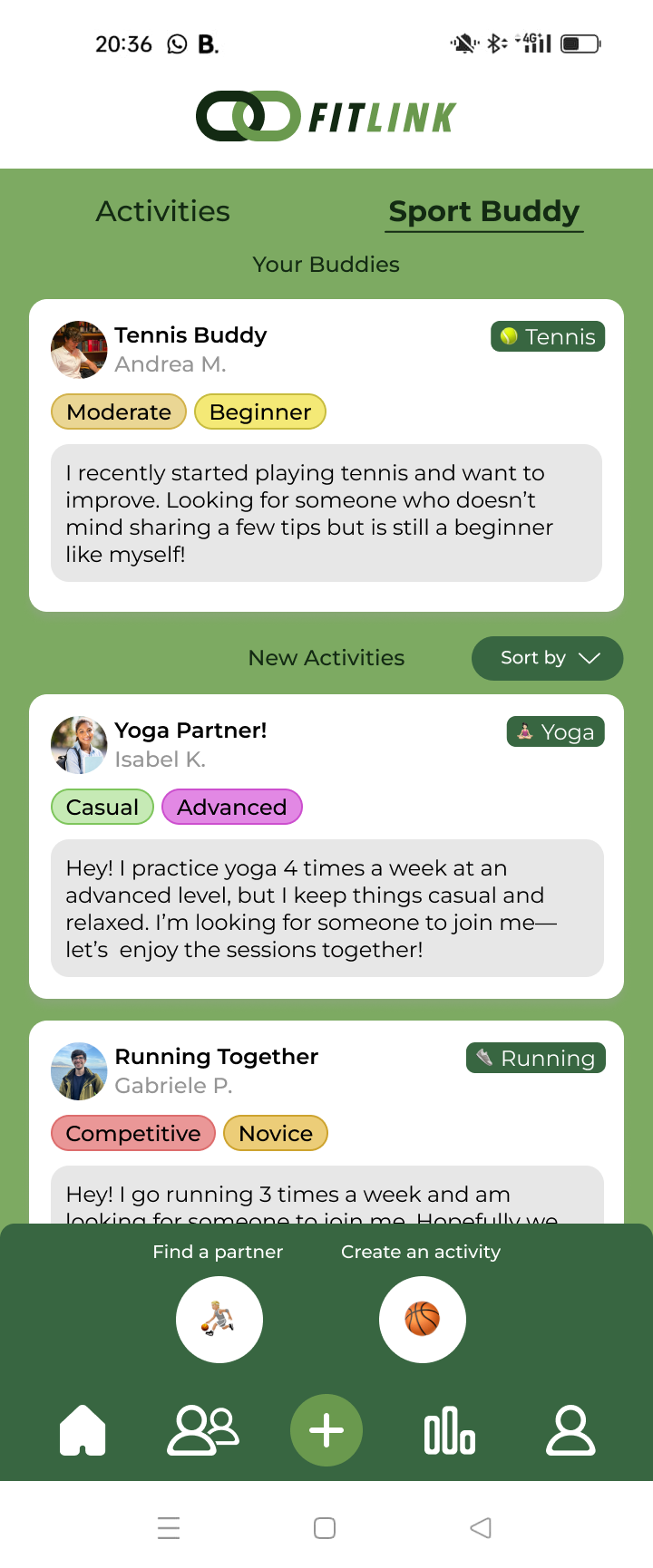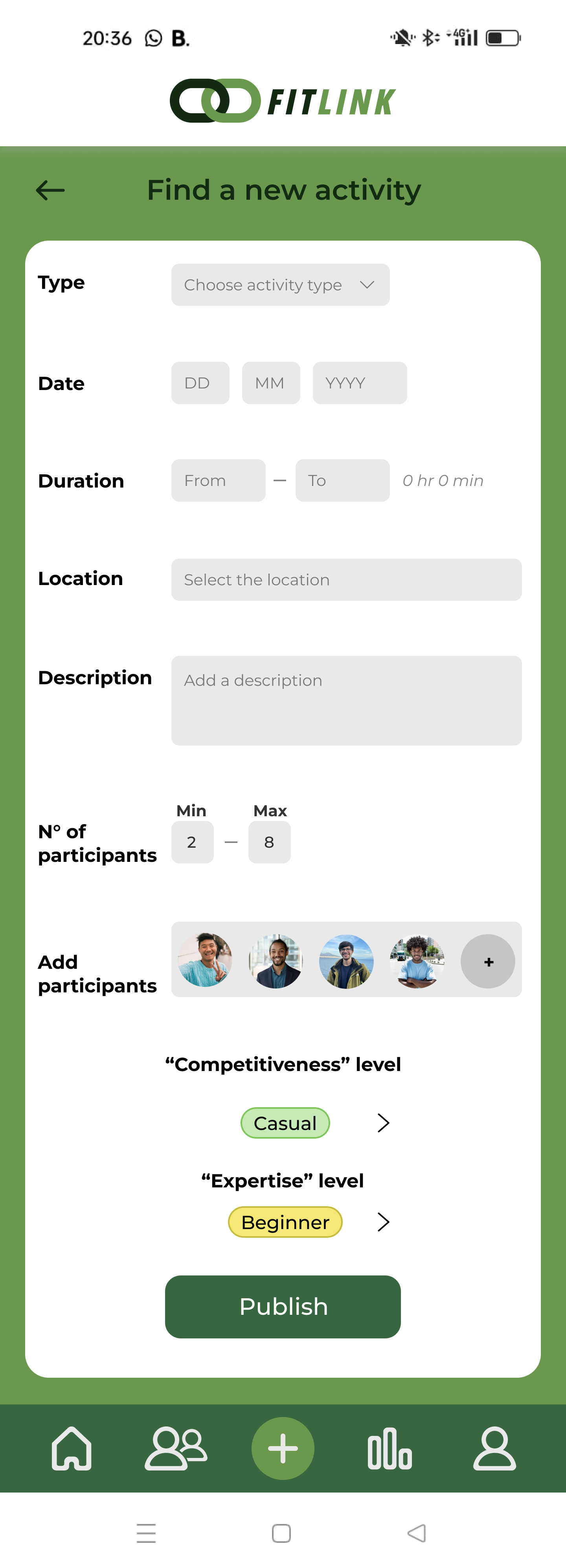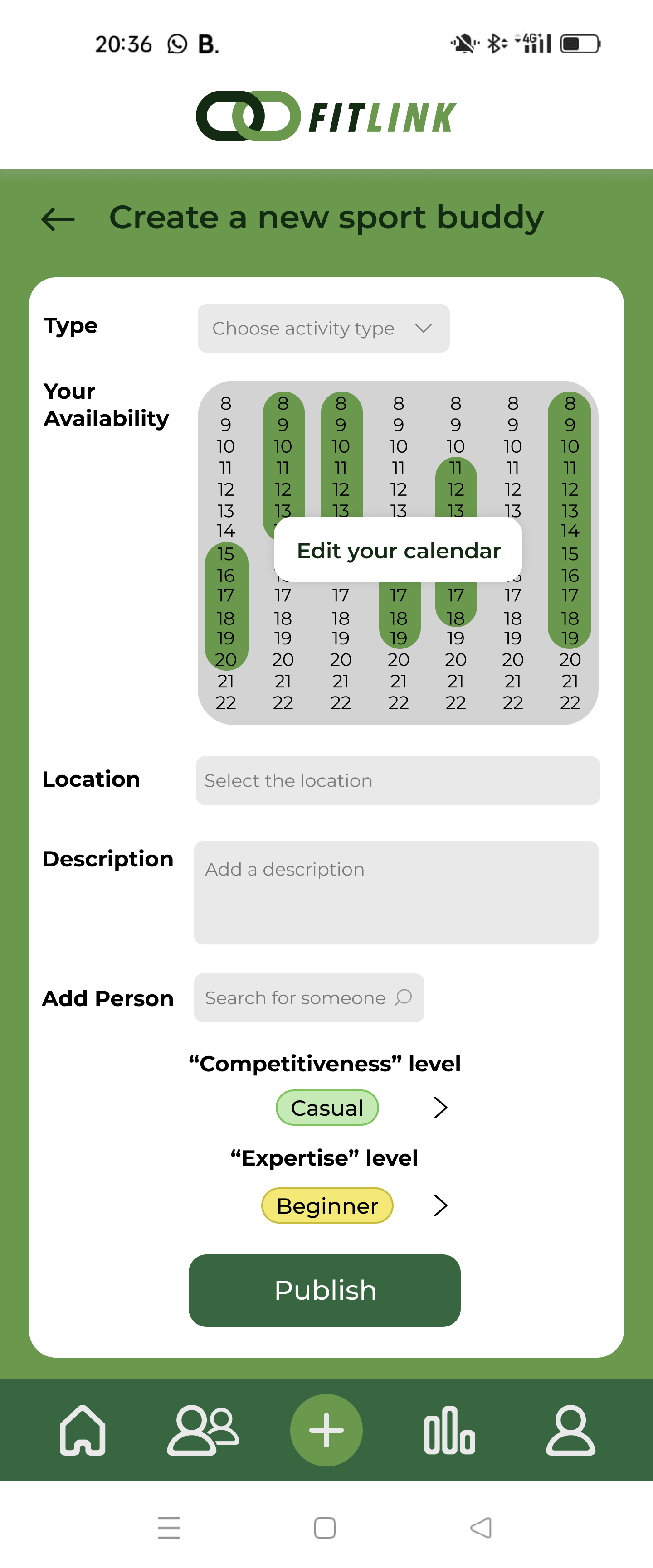Role:
UX Researcher, UX Designer
Tools:
Figma, Miro, Word, Canva Pen&Paper
Team:
3 HCI students, 2 Computer science students
Timeline:
June – July 2024
(4 weeks)
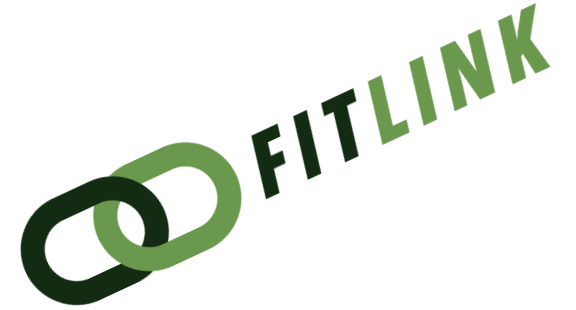
Problem
The university struggles to engage students in sports activities, with many exhibiting sedentary behaviours.
The majority of active users primarily stick to the gym and weight room, largely neglecting the other facilities available on campus.
Solution
An app designed to leverage the power of social interaction to reduce sedentary behaviours, increase participation in sports activities, and make campus facilities more accessible, encouraging users to try them out more easily.
The setting
In June 2024, the Universitat Autònoma de Barcelona (UAB) hosted the TechFit Challenge asking for help to increase its students’ involvement in sports and physical activity.
UAB faces challenges with low engagement in sports among its students and campus residents, with many conducting a sedentary lifestyle and not doing enough physical activity.
Furthermore, more than half of habitual sports facilities users primarily make use of the weight and gym room, with just a minority taking advantage of the other available resources on the campus (e.g.: fields, courts, sports rooms).
< 50% of users take full advantage of the available campus
sports facilities and resources
(e.g.: fields, courts, and sports rooms)
Such an unbalanced distribution of users across the facilities leads to overcrowding and confusion in certain areas while leaving others underutilized.
This results in a negative user experience and wasted resources for the university, as unused areas still incur high maintenance costs without being fully utilized.
The process
User research
As an initial step in developing a solution to address the issues reported by the UAB, I conducted preliminary user research to better understand, define, and finally present to the team the key stakeholders involved in the project. Ultimately, the following primary actors were identified:
The University:
- The main client and decision-making body
- Responsible for adopting, implementing, and promoting the solution across the institution.
- Ensure the alignment of the solution with the university’s ecosystem and values, improving its students wellbeing while enhancing the university’s services and efficiency.
The Students:
-
End-users and main beneficiaries of the solution.
-
Express and discuss their needs, preferences, and behaviours, driving the design of the solution.
- Gain access to more efficient sport services and enjoy a better experience. Feel participation in sports as a positive experience thanks to the environment and people around them.
University staff and professors:
-
Secondary users of the solution, could benefit from its introduction but are not the main target.
- They might require access to the same or similar services as primary users, though their usage patterns or needs could differ slightly (e.g.: professional commitments or time constraints).
Having our stakeholders in mind, we proceeded to conduct some literature research to understand possible ways to tackle the highlighted issues.

Findings revealed how social interaction and sharing objectives with others plays a significant role in encouraging engagement with physical activities and sports. Research disclosed how having company makes people more likely to participate in physical activities, and motivate them more to initiate and perpetrate such exercise[2, 3, 6].
Based on the information gathered from the literature review and the discussions during our preliminary meeting, we decided to propose a solution that leverages the positive impact of social interaction and companionship to encourage higher levels of physical activity and increase the use of various sports facilities on the UAB campus, thus also reducing the organisational problem the university reports.
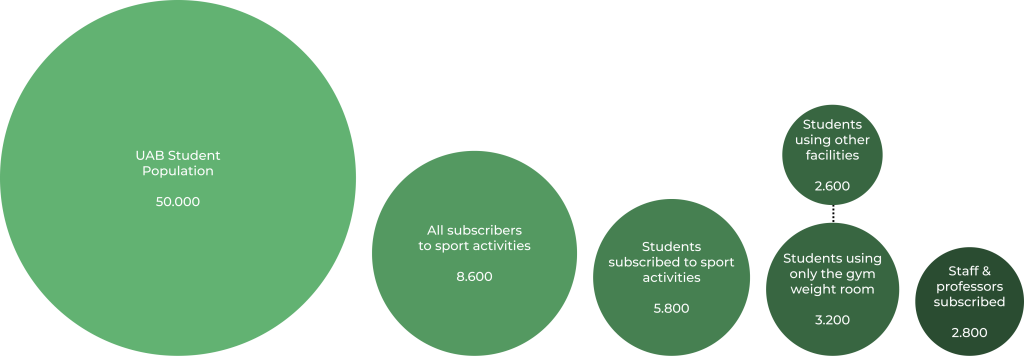
Users’ Motivational Model & Creating Personas
The Bartle Model [1], together with other frameworks (i.e.: Fogg Behavior Model [4]), proved valuable in shaping the ideation and development of our solution.
The former, in particular, helped us visualise different types of users interacting with an app which implements gamification and social interaction aspects [5]. Specifically, the Bartle Model divides users into 4 types of actors based on how they approach activities (i.e.: sports, games):

With these user types in mind, we created personas to help guide the design phase.
Each persona was created to reflect different personalities, fitness levels, and goals that actual users (i.e.: UAB students) might present, thus ensuring a user-centered design process from the start.
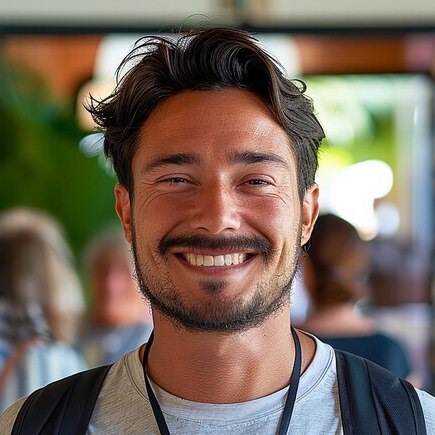
Marco
Marco is a sedentary university student. He has been studying at UAB for several months but he is struggling with finding new friends, as well as staying active (he knows physical activity is good for him, but he has not found a type of activity that he would like to stick to). He realises that he spends most of his time in the library alone instead of getting new experiences, and decides to change that by doing group sports together with other university students.
Goal: find a fun activity + make new friends
Bartle type: Socializer
Gamification aspects: comments, chat, social interaction tools
Fitness level:
beginner

Leah
Leah is a Master’s student at UAB who leads a very active lifestyle. She regularly goes to the gym, hikes, and runs but now she wants to try new activities offered by the university. While Leah enjoys tracking her personal progress, she isn’t interested in comparing her results with others — her focus is self-improvement. Nonetheless, when considering trying a new sport, she would prefer having a partner to explore it with, motivating each other and achieving better results together.
Goal: find a fitness buddy + improve together
Bartle type: Achiever
Gamification aspects:
badges, sharing their achievements with others
Fitness level: advanced
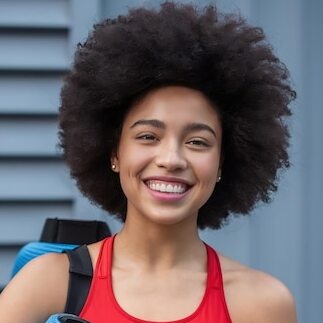
Anna
Anna is very outgoing and friendly.
She just started attending UAB and she is very excited to try everything, including different types of physical activities: from running and rock climbing to volleyball and other team sports. Moreover, she likes exploring new places (be it through running a new route or simply playing on a different field) and meeting new people. She tends to get bored quickly from doing the same thing, so variety is very important to her.
Goal: try new types of activities + go to new places
Bartle type: Explorer
Gamification aspects:
unique badges (e.g. “10 unique activities tried”)
Fitness level: intermediate
Creating Sketches & Application Structure
During the ideation of the app, the idea of connecting with others and creating social interaction was always a central goal for us, as we recognised most users would enjoy sports for its social bonding aspects.
Nonetheless, we also always posed great attention to create a solution that could satisfy all the four types of users reported above.
To develop the design of FitLink, we analyzed the market of existing fitness and sports apps, from general ones (i.e.: Apple Health, Google Fit, Huawei Health) to more specialized platforms (i.e.:Strava).
This approach helped us incorporate familiar features and design aspects, ensuring a smoother user experience from the app’s first launch by building on what users are already used to.

The app was initially envisioned with five main pages:
- A home page that would display a feed of activities and events relevant to each user, along with a menu allowing them to create new ones or look for “sport buddies” to train with.
- A social page would allow users to communicate directly with their “links” (friends) to organize and manage sports events or training sessions.
- A profile page was ideated to contain the user’s personal information, sports of interest, and level of proficiency and competitiveness in these.
- A statistics page to provide information and a log of past activities, showcasing the user’s position relative to others in the ranking system.
- An achievement page, allowing users to track their progress through badges and challenges.
The statistics and achievements pages were designed to cater to the competitive personalities research for challenge against others (“killer” users) or against themselves (“achievers”).
Such detailed provision through the profile ensures a personalised experience by tailoring the activities shown in the feed to match the user’s preferences and skill level. In this way, we ensure, even before user’s attendance, that each proposed activity proves engaging but still accessible based on the level of expertise and desired competitiveness.
After the design of each page singularly, we rendered the application architecture, reflecting also on the user flow to reach every relevant task

Designing the solution
[A functioning version of the prototype can be found at Fitlink Figma Prototype]
The final design consisted of four main pages around which FitLink revolves.

Home-screen
Devided into two main sections, showcasing both upcoming events that the user has reserved and new ones they may be interested in.
- Activities: displays single sport events created by other users that the user has joined or may be interested in joining. Once an event is completed, its post disappears.
- Sport buddy: Dedicated to helping users find a partner for regular training sessions. The goal is to establish a recurring shared schedule promoting long-term sports partnerships.
While the Sport Buddy section encourages stronger one-to-one connections between trainees, we believe the Activities section also has the potential to encourage group formation, as users may choose to propose again the event and continue practising together after meeting at the first activity.
Original features:
- Activity Tags: indicate the type of sport associated with the event.
- Competitiveness Tag: Allows users to quickly judge the level of competitiveness for each event, ranging from “casual” to “moderate” and “competitive”.

- Expertise Tag: Displays the expected skill level of participants, ranging from “beginner” to “professional,” with three intermediate levels

The introduction of the tag system was ideated to limit situations of potential uneasiness given different competitiveness or expertise level in the joined event. Thanks to this system every user has the chance to know what kind of event they will join and what to expect from it (i.e., a relaxed match for spending time together and unwinding, or a competitive match to challenge their skills and push their limits).
Quick Access Menu & Create posts
On each screen’s lower section the quick access menu allows the user to navigate between the four main sections from wherever they are in the app.
The middle icon “+” opens a secondary menu allowing the user to create an activity or a sport buddy post through the dedicated pages.
An example of how the sport-buddy and activity tabs would look when opened (with content already published by another user or newly created post by the current user)

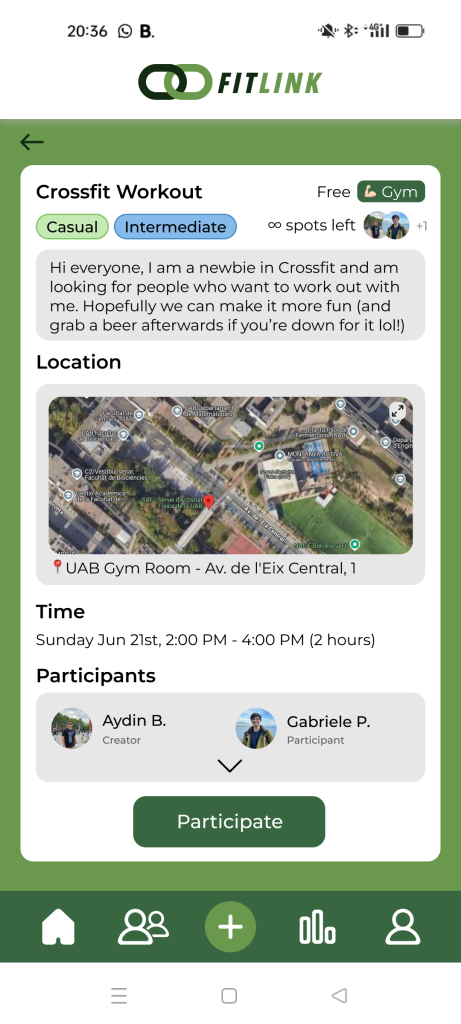
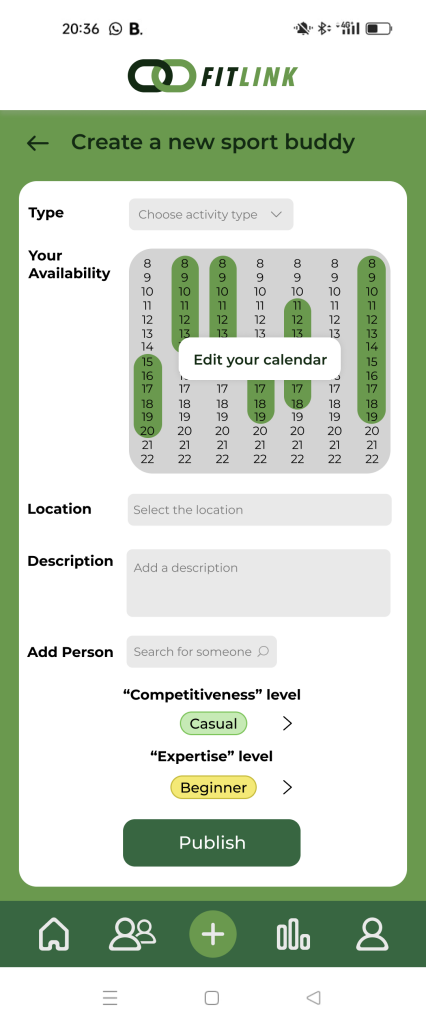
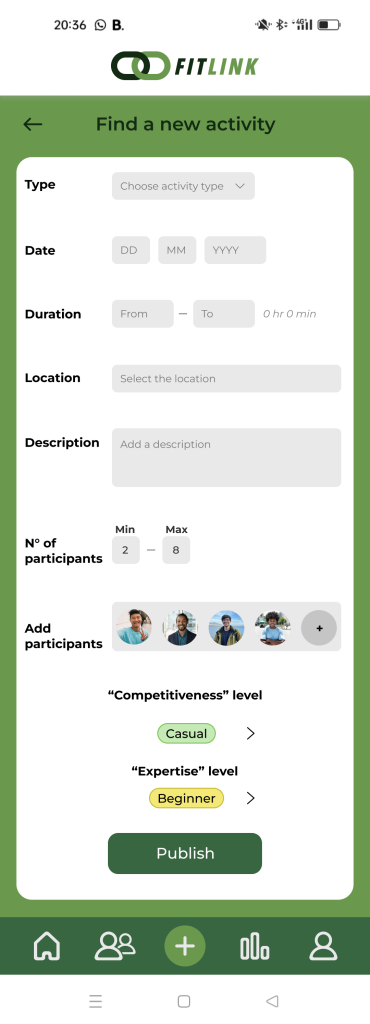
“Links” page
Where all “links” (friends within the app) are presented.
From this page the user can directly interact with them to manage or arrange their next sport appointments.
New potential users with similar interests will be displayed here to facilitate interaction with new potential sports partners.
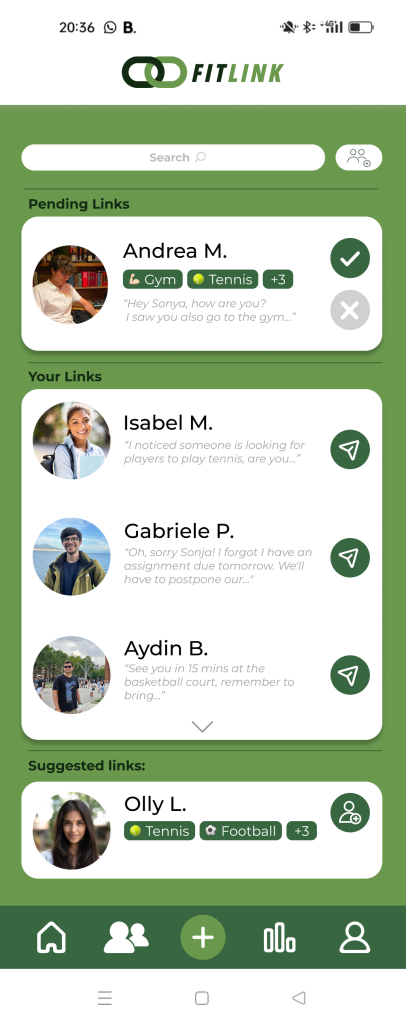
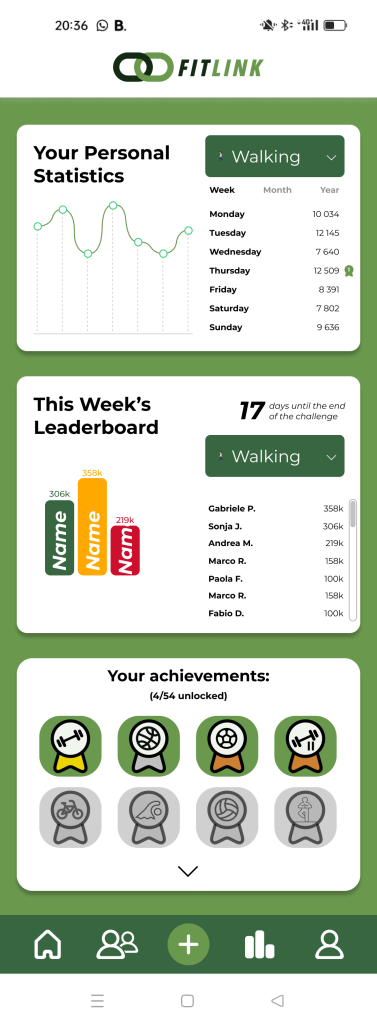
Statistics & Achievements page
This screen provides information and records about the user’s performance and allows them to compare their results with others on a sport-specific leaderboard.
For users interested in self-improvement and earning rewards, progressive challenges are available. As users achieve new milestones, they unlock badges at increasing levels (bronze, silver, and gold) encouraging continued progress and goal-setting.
Profile page
Includes personal information and interests of the user, allowing them to show others what they like to practice and the goals they have reached.
Here the user can set their sports of interest and for each of them indicate their level of expertise and preferred level of competitiveness, allowing the system to calibrate proposed posts in the feed to satisfy their requirements.
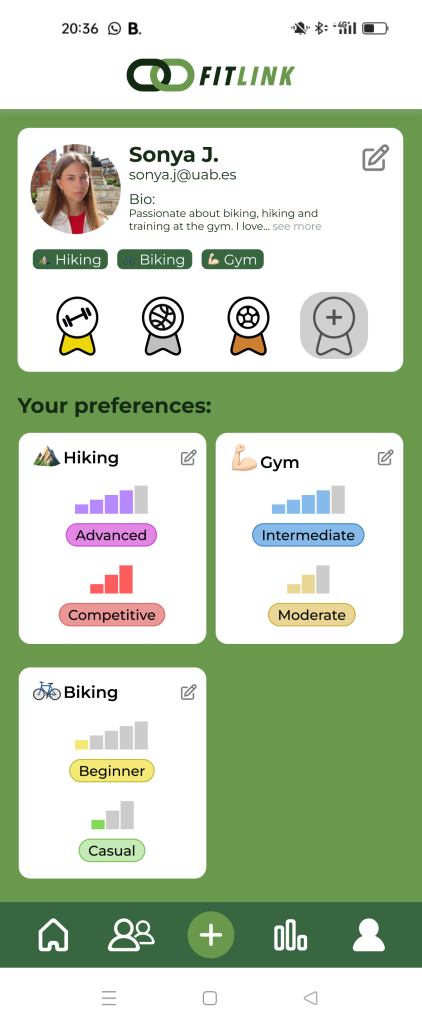
Final Considerations
The project concluded with the presentation of the completed prototype to the UAB commission.
While the prototype already features a detailed high-fidelity interface, the next phase will involve user testing to refine the design, ensuring it aligns with users’ needs and logic. Additionally, gathering experts’ evaluations could help making sure the application adheres to established heuristics and design principles.
Useful methods for achieving these goals may include the think-aloud protocol, which will reveal users’ thought processes and how they mentally organise the app’s information, unveiling potential fallacies in the app design, and heuristic evaluation to assess its compliance with usability guidelines.
References
[1] Richard Bartle. 1996. Hearts, Clubs, Diamonds, Spades: Players Who Suit Muds. Journal of MUD research 1, (1996), 1:19.
[2] Corina Berli, Niall Bolger, Patrick E. Shrout, Gertraud Stadler, and Urte Scholz. 2018. Interpersonal Processes of Couples’ Daily Support for Goal Pursuit: The Example of Physical Activity. Pers Soc Psychol Bull 44, 3 (March 2018), 332–344. https://doi.org/10.1177/0146167217739264
[3] R. M. Carr, A. Prestwich, D. Kwasnicka, C. Thøgersen-Ntoumani, D. F. Gucciardi, E. Quested, L. H. Hall, and N. Ntoumanis. 2019. Dyadic interventions to promote physical activity and reduce sedentary behaviour: systematic review and meta-analysis. Health Psychology Review 13, 1 (January 2019), 91–109. https://doi.org/10.1080/17437199.2018.1532312
[4] Bj Fogg. 2009. A behavior model for persuasive design. In Proceedings of the 4th International Conference on Persuasive Technology, April 26, 2009. ACM, Claremont California USA, 1–7. https://doi.org/10.1145/1541948.1541999
[5] Yuan Jia, Bin Xu, Yamini Karanam, and Stephen Voida. 2016. Personality-targeted Gamification: A Survey Study on Personality Traits and Motivational Affordances. In Proceedings of the 2016 CHI Conference on Human Factors in Computing Systems, May 07, 2016. ACM, San Jose California USA, 2001–2013. https://doi.org/10.1145/2858036.2858515
[6] Zofia Szczuka, Ewa Kulis, Monika Boberska, Anna Banik, Magdalena Kruk, Jan Keller, Nina Knoll, Urte Scholz, Charles Abraham, and Aleksandra Luszczynska. 2021. Can individual, dyadic, or collaborative planning reduce sedentary behavior? A randomized controlled trial. Social Science & Medicine 287, (October 2021), 114336. https://doi.org/10.1016/j.socscimed.2021.114336
